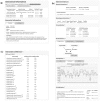PAIR: the predicted Arabidopsis interactome resource
- PMID: 20952401
- PMCID: PMC3013789
- DOI: 10.1093/nar/gkq938
PAIR: the predicted Arabidopsis interactome resource
Abstract
The predicted Arabidopsis interactome resource (PAIR, http://www.cls.zju.edu.cn/pair/), comprised of 5990 experimentally reported molecular interactions in Arabidopsis thaliana together with 145,494 predicted interactions, is currently the most comprehensive data set of the Arabidopsis interactome with high reliability. PAIR predicts interactions by a fine-tuned support vector machine model that integrates indirect evidences for interaction, such as gene co-expressions, domain interactions, shared GO annotations, co-localizations, phylogenetic profile similarities and homologous interactions in other organisms (interologs). These predictions were expected to cover 24% of the entire Arabidopsis interactome, and their reliability was estimated to be 44%. Two independent example data sets were used to rigorously validate the prediction accuracy. PAIR features a user-friendly query interface, providing rich annotation on the relationships between two proteins. A graphical interaction network browser has also been integrated into the PAIR web interface to facilitate mining of specific pathways.
Figures


Similar articles
-
Computational identification of potential molecular interactions in Arabidopsis.Plant Physiol. 2009 Sep;151(1):34-46. doi: 10.1104/pp.109.141317. Epub 2009 Jul 10. Plant Physiol. 2009. PMID: 19592425 Free PMC article.
-
AIM: a comprehensive Arabidopsis interactome module database and related interologs in plants.Database (Oxford). 2014 Dec 4;2014:bau117. doi: 10.1093/database/bau117. Print 2014. Database (Oxford). 2014. PMID: 25480687 Free PMC article.
-
AtPID: Arabidopsis thaliana protein interactome database--an integrative platform for plant systems biology.Nucleic Acids Res. 2008 Jan;36(Database issue):D999-1008. doi: 10.1093/nar/gkm844. Epub 2007 Oct 25. Nucleic Acids Res. 2008. PMID: 17962307 Free PMC article.
-
Global protein interactome exploration through mining genome-scale data in Arabidopsis thaliana.BMC Genomics. 2010 Nov 2;11 Suppl 2(Suppl 2):S2. doi: 10.1186/1471-2164-11-S2-S2. BMC Genomics. 2010. PMID: 21047383 Free PMC article.
-
A kaleidoscopic view of the Arabidopsis core cell cycle interactome.Trends Plant Sci. 2011 Mar;16(3):141-50. doi: 10.1016/j.tplants.2010.12.004. Epub 2011 Jan 11. Trends Plant Sci. 2011. PMID: 21233003 Review.
Cited by
-
Exploring dynamic protein-protein interactions in cassava through the integrative interactome network.Sci Rep. 2020 Apr 16;10(1):6510. doi: 10.1038/s41598-020-63536-0. Sci Rep. 2020. PMID: 32300157 Free PMC article.
-
PRIN: a predicted rice interactome network.BMC Bioinformatics. 2011 May 16;12:161. doi: 10.1186/1471-2105-12-161. BMC Bioinformatics. 2011. PMID: 21575196 Free PMC article.
-
PlantPAN 2.0: an update of plant promoter analysis navigator for reconstructing transcriptional regulatory networks in plants.Nucleic Acids Res. 2016 Jan 4;44(D1):D1154-60. doi: 10.1093/nar/gkv1035. Epub 2015 Oct 17. Nucleic Acids Res. 2016. PMID: 26476450 Free PMC article.
-
Reconstruction and Application of Protein-Protein Interaction Network.Int J Mol Sci. 2016 Jun 8;17(6):907. doi: 10.3390/ijms17060907. Int J Mol Sci. 2016. PMID: 27338356 Free PMC article. Review.
-
Basic Protein Modules Combining Abscisic Acid and Light Signaling in Arabidopsis.Front Plant Sci. 2022 Jan 3;12:808960. doi: 10.3389/fpls.2021.808960. eCollection 2021. Front Plant Sci. 2022. PMID: 35046987 Free PMC article. Review.
References
-
- Krogan NJ, Cagney G, Yu H, Zhong G, Guo X, Ignatchenko A, Li J, Pu S, Datta N, Tikuisis AP, et al. Global landscape of protein complexes in the yeast Saccharomyces cerevisiae. Nature. 2006;440:637–643. - PubMed
-
- Ho Y, Gruhler A, Heilbut A, Bader GD, Moore L, Adams SL, Millar A, Taylor P, Bennett K, Boutilier K, et al. Systematic identification of protein complexes in Saccharomyces cerevisiae by mass spectrometry. Nature. 2002;415:180–183. - PubMed
-
- Rual JF, Venkatesan K, Hao T, Hirozane-Kishikawa T, Dricot A, Li N, Berriz GF, Gibbons FD, Dreze M, Ayivi-Guedehoussou N, et al. Towards a proteome-scale map of the human protein-protein interaction network. Nature. 2005;437:1173–1178. - PubMed
Publication types
MeSH terms
Substances
LinkOut - more resources
Full Text Sources

